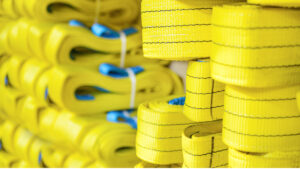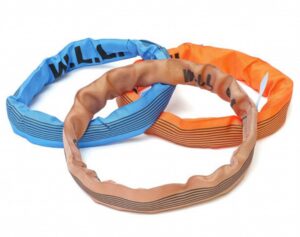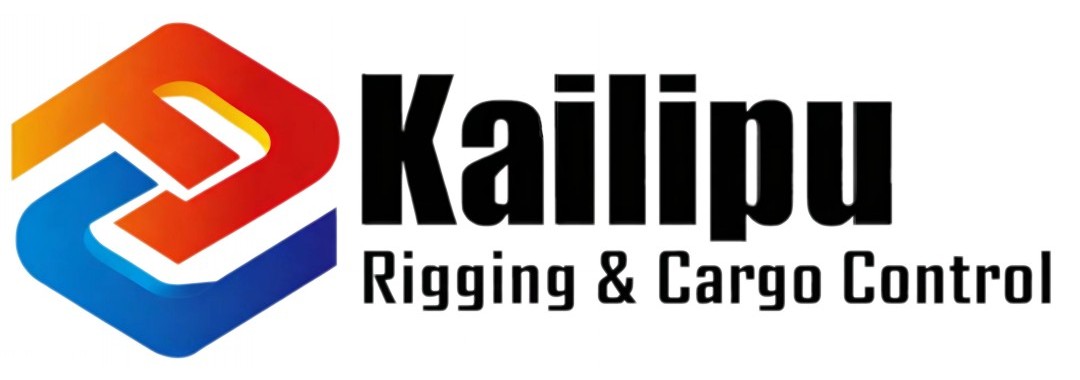Types of EN 1492 Webbing Slings: Differences Between EN 1492-1 (Flat Woven Webbing Slings) and EN 1492-2 (Round Slings)
EN 1492 Webbing slings are essential tools in various industries for lifting and hoisting heavy loads. To ensure safety and reliability, these slings must meet specific standards. The European Standard EN 1492 defines the requirements for webbing slings, divided into two main categories: EN 1492-1 for flat woven webbing slings and EN 1492-2 for round slings. In this blog, we will explore the differences between these two types of webbing slings.
EN 1492-1: Flat Woven Webbing Slings
Flat woven webbing slings, as defined by EN 1492-1, are versatile and commonly used for various lifting applications. These slings are made from polyester, polyamide, or polypropylene fibers, providing strength and durability.

Characteristics of EN 1492-1 Flat Woven Webbing Slings:
Material: Typically made from polyester, which offers high strength, durability, and resistance to stretching and moisture.
Construction: Consists of woven flat strips of webbing material.
Design: Available in single or multiple layers to handle different load capacities.
End Fittings: Can have different end fittings such as eyes, hooks, or links, depending on the application.
Identification: Must have clear markings, including the Working Load Limit (WLL), material, length, and manufacturer information.
Advantages of -1 EN 1492 webbing sling:
Flexibility: Easily conforms to the shape of the load, reducing damage to both the sling and the load.
Lightweight: Easier to handle and transport compared to other lifting equipment.
Cost-effective: Generally less expensive than other types of slings.
Applications:
Construction
Warehousing
Transportation
Manufacturing
EN 1492-2: Round Slings
Round slings, defined by EN 1492-2, are another popular type of webbing sling. These slings are constructed from a continuous loop of high-tenacity polyester yarn encased in a woven polyester cover.

Characteristics of EN 1492-2 Round Slings:
Material: Made from high-tenacity polyester yarn, providing excellent strength and resistance to wear and tear.
Construction: Comprises a continuous loop of yarn encased in a protective polyester cover.
Design: Available in various lengths and capacities, typically color-coded for easy identification of load limits.
Identification: Must have clear markings, including the Working Load Limit (WLL), material, length, and manufacturer information.
Advantages:
High Strength: Capable of lifting very heavy loads with a high safety factor.
Durability: The encased yarn construction provides excellent protection against abrasion and damage.
Softness: Gentle on delicate or finished surfaces, reducing the risk of damage to the load.
Applications:
Heavy lifting in construction
Marine and offshore operations
Machinery moving
Rigging
Key Differences Between EN 1492-1 and EN 1492-2
1. Construction:
- EN 1492-1: Flat woven webbing slings are made from woven strips of material.
- EN 1492-2: Round slings consist of a continuous loop of yarn encased in a protective cover.
2. Load Distribution:
- EN 1492-1: The flat design allows for even load distribution across the width of the sling.
- EN 1492-2: The round design can concentrate the load on a smaller area, providing higher lifting capacity.
3. Flexibility and Softness:
- EN 1492-1: More flexible and conforming to the shape of the load, ideal for delicate or irregularly shaped items.
- EN 1492-2: Softer and less likely to damage delicate surfaces, making it suitable for sensitive loads.
4. Weight and Handling:
- EN 1492-1: Generally lighter and easier to handle.
- EN 1492-2: Can be heavier but provides higher lifting capacities for larger loads.
5. Durability:
- EN 1492-1: Durable but more susceptible to abrasion and damage without protective coatings.
- EN 1492-2: The encased yarn construction offers better protection against wear and tear.
EN 1492 Webbing Sling
Both EN 1492-1 flat woven webbing slings and EN 1492-2 round slings play crucial roles in lifting operations. Understanding the differences between these two types of slings helps in selecting the appropriate sling for specific applications, ensuring safety, efficiency, and reliability. Always ensure that the slings you use comply with the EN 1492 standard and are inspected regularly for signs of wear and damage.
By choosing the right type of webbing sling, you can enhance the safety and effectiveness of your lifting operations.
Your Premier Choose for EN 1492 Webbing Slings in China
As a leading supplier of professional European standard EN 1492 webbing slings in China, we are committed to delivering the highest quality products that ensure the safety and stability. Our extensive range of webbing slings, including flat woven webbing sling, endless sling, round sling, eye and eye round slings. All are designed to withstand the EN 1492 standard. We pride ourselves on our rigorous quality control processes, innovative design solutions, and exceptional customer service. By choosing our supplies, you are investing in the reliability and performance.
Browse our website or contact our team at [email protected], Kailipu will work with you to make better marine mooring accessories components.
Related Source:
https://qd-kailipu.com/product-category/webbing-sling/round-sling-eye-and-eye/

